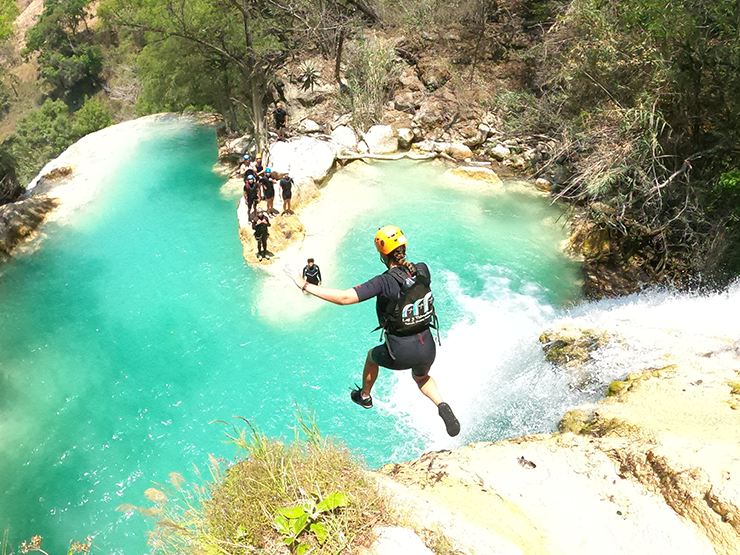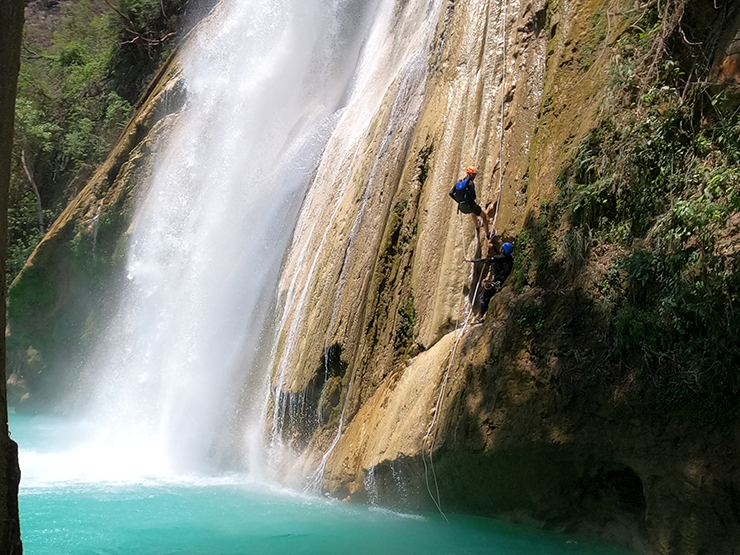Exploring the rich and wonderful Chiapas, Mexico
Words & Photography: Suzanne Morphet
“Close your eyes,” says Ángel, our guide, “and then walk forward until I say stop.”
Half a dozen of us stand mid-stream in the most picturesque river you can imagine. In Mexico’s southernmost state of Chiapas, the Rio San Vicente flows like a winding green ribbon out of the mountains and down a forested slope of stately Sabino trees to fields of sugarcane below.

We’ve made our way along the river by jumping off ledges and letting the current carry us from one rocky outcropping to the next, where we climb out and joyfully jump in again.
The more daring among us jump or dive from the tops of waterfalls as high as seven metres into the frothy water below.
Now, we follow Ángel’s instructions and hold hands to keep our balance as the current pushes against our legs. When Ángel tells us to open our eyes, we let out a collective gasp.
We’re standing near the brink of a spectacular waterfall. Just metres away, water surges over a wide limestone lip and plunges 60 metres, replenishing the natural turquoise pools below.
This tour with Las 3 Tzimoleras takes place on just the second day of our week-long adventure in Chiapas, but I’m already enthralled with a state that’s so different from the picture of Mexico I carry in my head.
Instead of basking on beaches, listening to canned music and hearing mostly English spoken at a resort favoured by foreigners, I’ll be exploring rivers, listening to live music and practising my minimal Spanish with locals in some of the oldest towns in Mexico.

And because we’re here in December, we also get to see how Mexicans in Chiapas celebrate Christmas.
Our first evening we’re in Comitán, a pueblo magico close to Mexico’s border with Guatemala. The town square is ablaze with colour. People arrive on foot, walking under an archway of stars and pausing to have their photos taken next to rearing reindeer or from inside enormous baubles.
A large Christmas tree wrapped in red ribbons dominates one corner of the square while the Spanish colonial town hall sparkles with columns of light. A marimba orchestra—with trumpets, drums and, of course, a marimba (a type of xylophone) —plays Cumbia-style music, a genre quintessential to Mexico.
The marimba is thought to have been brought to the new world from Africa by slaves. Today, it’s heard throughout southern Mexico, but Chiapas is known for its ensembles that combine two or three One day, we ride horseback to the town of San Juan Chamula, another Tzotzil community, where the church of St. John the Baptist resembles a Mayan temple. Inside, thousands of candles flicker in the dark and incense perfumes the air. People sit on the floor—there are no pews—and perform various rituals, including animal sacrifice.
We watch in astonishment as a young woman silently strangles a chicken, its legs twitching from the top of a bag she’s holding it in, while her children sit beside her drinking from a bottle of Coca-Cola.
“They come to the temple when they have a problem,” our guide, Ramses Borraz Balinas, explained later. “It could be someone is sick, your sheep are sick, maybe you have a bad neighbour.”
Drinking coke, which causes burping, facilitates the release of evil spirits, he added.
If San Juan Chamula feels a little dark and oppressive, the town of Chiapa de Corzo is bright and joyful. Christmas celebrations begin the evening we arrive with the lighting of the tree in the main square. Afterwards, the crowd gathers around an orchestra including a couple of marimbas, each played by four men using long-handled mallets.
Two special guests stand head and shoulders above everyone else in the crowd. They’re mojigangas—giant puppets with expressive faces on heads made from papier-mâché. One is a buxom brunette in a skirt, the other a man wearing a red checked shirt and black pants. They bounce to the beat of the music, their cloth arms swinging freely. Mojigangas were brought from Spain by colonizers in the 17th century or earlier.
Back at our hotel, La Ceiba, more entertainment awaits. The owner wants to give us a taste of the Great Feast, a festival held every year from January 4 to 23. It recalls the legend of a wealthy Spanish woman who arrived in the 17th century in search of a cure for her sick son. Local men dressed up as pale-faced Spaniards and danced “para el chico” (for the boy). Miraculously, the boy was healed.
Today, male dancers—parachicos—wear wooden masks with blue or green eyes and bristly blonde wigs along with striped ponchos. Accompanied by musicians, they shake chinchines (maracas) and dance in honour of three Roman Catholic saints. Women are even more colourfully dressed, wearing full, flouncy skirts and blouses made from satin and embroidered with flowers.

Over dinner, which includes soup flavoured with chipilin, a wild herb that’s popular in Chiapas, we’re treated to an authentic musical performance. In 2010, UNESCO recognized the dance of the parachicos as an Intangible Cultural Heritage of Humanity. Even though you can see men dressed as parachicos elsewhere in Chiapas, the Great Feast is held only here.
And that’s the thing about traveling off the beaten track. You never know what you’re going to find, but whatever it is, it’ll be like nowhere else.
For more information, go to visitchiapas.com/en


 Secrets and lives — AND THE 7 SINS with Faith Wilson
Secrets and lives — AND THE 7 SINS with Faith Wilson